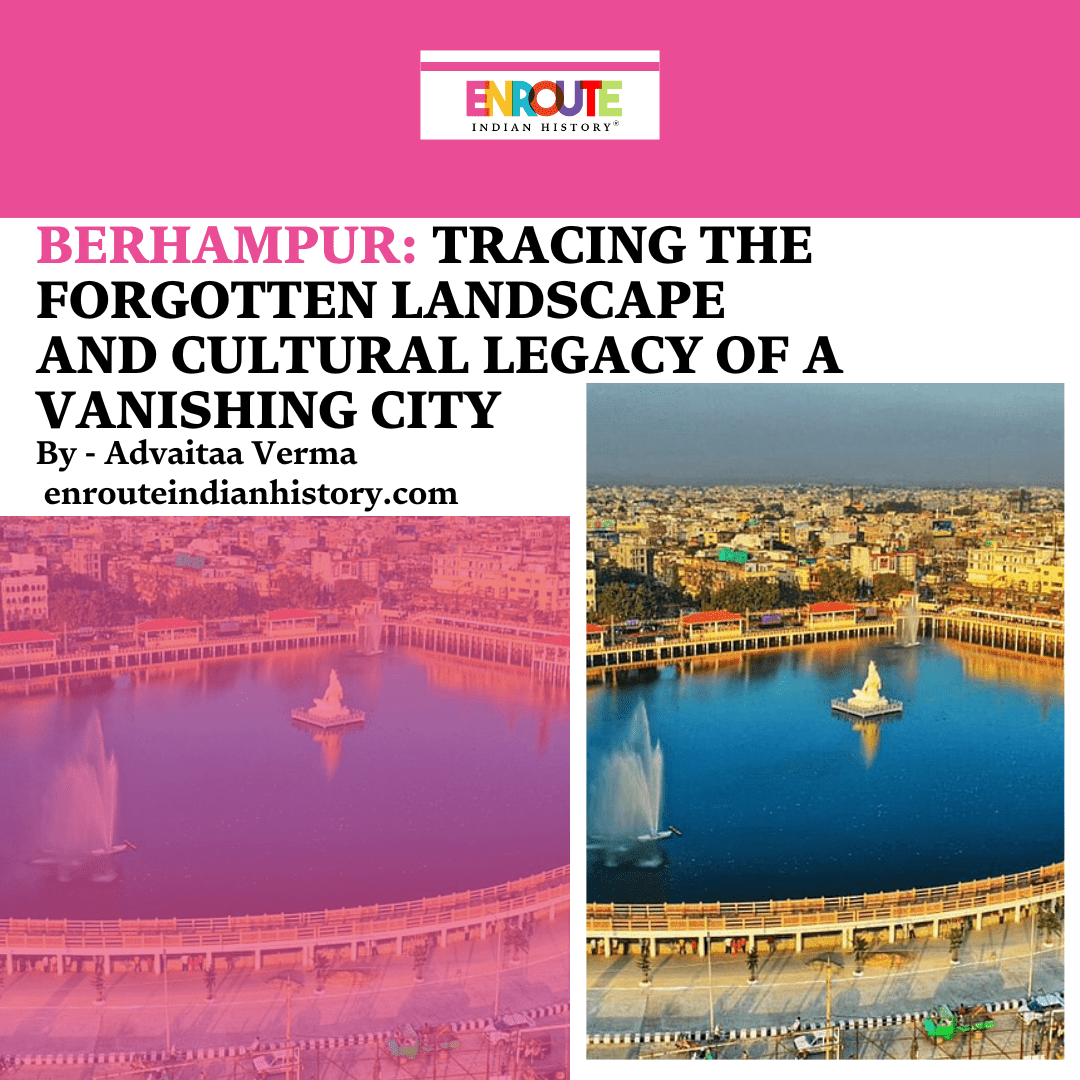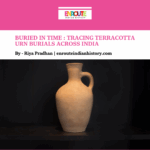Berhampur: Tracing the Forgotten Landscape and Cultural Legacy of a Vanishing City
- iamanoushkajain
- May 10, 2025

By Advaitaa Verma
The historiography of Indian urban centers have often prioritized places that are politically
strategic capitals, temple towns and colonial administrative centres. The culturally rich and
commercially important hubs were neglected and forgotten in history. One such lost and
forgotten city of India is Berhampur, a small city in the eastern coastline in Ganjam district of
Orissa. This city was once an important trade center, and played a significant role in the maritime
trade networks of the Kalinga region. Despite the strategic position of the city and its historical
connections, Berhampur still remains an underexplored subject in academic research as well as
public historical consciousness.
The city’s historical trajectory was shaped by its indigenous trade networks and culture; it
positions the city within the broader discourse of lost cities of India, in terms of erased historical
identity. This article outlines the importance of Berhampur within the framework of lost and
neglected urban centers by tracing the maritime trade, cultural heritage and economic
development. Using a multidisciplinary approach, this article critically re-examines Berhampur’s
historical and economic decline.
GEOGRAPHICAL BACKGROUND
Berhampur, also known as Brahmapur, is a coastal city located in the Ganjam district of Odisha,
India. Situated in the eastern part of the country, it lies at approximately 19.32°N latitude and
84.79°E longitude, near the Bay of Bengal. The city is positioned along the national highway,
which connects it to major urban centers such as Bhubaneswar, the capital and Visakhapatnam in
Andhra Pradesh. Its proximity to the eastern coastline has historically played a significant role in
shaping its maritime trade connections. The region surrounding Berhampur features a diverse
landscape, including fertile plains, river valleys, and coastal ecosystems. The Rushikulya River,
an important water body in southern Odisha, flows near the city and has historically supported
agriculture and trade. The climate is classified as tropical wet and dry, with hot summers,
moderate rainfall during the monsoon season, and mild winters. Its strategic location, combined
with a rich historical legacy, has contributed to its significance as a center for commerce, transport, and traditional crafts, despite its gradual decline in maritime prominence (Panigrahi,
2023).
HISTORICAL BACKGROUND OF BERHAMPUR
Berhampur was situated in Ganjam district, was the most populous town of the district, named
after Lord Brahmeswara, a deity in Hinduism. This city has been a core part of the Kalinga
empire, as it was an important trade center during the rule of Kalinga empire in 3 rd century BCE
(Panigrahi, 2023). After Ashoka conquered the Kalinga region in 261 BCE, the city was never
mentioned; until later in the 17 th century when people migrated and settled here. The chief of
Dera community, Kota Chandramani Kubera Senapati, led his community to migrate from
Rajahmundry to Berhampur, around 1662-1672 (Panigrahi, 2023). They settled down in this city
and introduced their hereditary profession of weaving tussar silken products or Patta Matha.
During the British period, the Ganjam Garhjat had 22 zamindars, the British established their
command over southern Odisha in 1766 and included the whole region under the Madras
Presidency. The district headquarters of Ganjam was set up at Potangarhin 1768. Later, in 1815,
an epidemic broke out, this led to a shift of headquarters from Potangarh to Berhampur including
the civil and military personnel. Berhampur was formed into a taluka and in 1867, declared as a municipality area and was upgraded to a municipal corporation on 29 th December 2008
(Panigrahi, 2023).
THE KALINGAN MARITIME LEGACY
The city of Berhampur, has historically served as a significant node in maritime trade networks
as it connected eastern India to major ports and cities in Southeast Asia, Middle East and beyond
(Patra, 2013). Due to its proximity to Bay of Bengal, it became a strategic location along the
ancient and medieval trade routes. The region of Kalinga was known for its large-scale maritime
trade with Southeast Asia, notably during the reign of Chedis, Satavahanas, and Eastern Ganga
dynasties. Berhampur, being close to the coastline acted as a transit point for the goods between
the hinterland and seaports such as Palur and Kalingapatnam (Patra, 2013). References to
Odisha’s maritime prowess can be found in writings of Hiuen Tsang and the Palur port is
mentioned as a major harbor in Greek, Roman and Chinese records. The well-known ancient
ports of Odisha are mentioned in classical Indian texts or foreign accounts, but Berhampur does
not have direct mention (Patra, 2013). Although, indirect references are seen that point towards
this region such as historical records, inscriptions and colonial-era documents. Mention of
Kalinga being a powerful region and the expertise and prowess of its maritime trade are evident
in the texts. These texts include Ramayana, Mahabharata, Jataka tales, inscriptions of Rajendra
Chola dated to 11 th century CE and colonial-era documents such as British Gazetteers and East
India Company records (18 th -19 th century CE). Oral traditions suggest that merchants and settlers
from Berhampur and neighboring areas established communities in Bali and Myanmar, the
Odisha-Bali festival, that is still celebrated today commemorates these historical ties
(Choudhury, 2018). Despite being a rich maritime legacy, Berhampur’s prominence faded due to
multiple factors such as the British East India Company supporting new and larger ports such as
Kolkata, Chennai and Visakhapatnam; destruction of local industries such as the textile industry
of Berhampur. Other reasons include geopolitical shifts, silting of river mouths (Patra, 2013).
CULTURAL LEGACY OF BERHAMPUR
Berhampur is a city of immense cultural significance, shaped by its maritime past, religious
traditions and artisanal heritage. The city’s cultural identity is deeply intertwined with Odisha’s
maritime traditions, one such folklore is of the Kalinga Sadhavas (Choudhury, 2018). The oral
history suggests that these ancient seafarers or merchants from Berhampur were actively trading
and engaging in commerce with Southeast Asia, Sri Lanka and the Middle East (Patra, 2020).
There are various festivals that highlight the maritime trade traditions and its importance, these
festivals are celebrated even today, and they are as follows:
1. Boita Bandana Festival: It is a boat festival celebrated during Karthik Purnima. It is
celebrated to show the maritime history and pay tribute to brave sailors who set sail from
this region. People make miniature boats of banana stems, paper and other materials and
set them afloat in rivers, ponds or sea and also sing traditional songs (Choudhury, 2018).
2. Odisha-Bali Yatra Festival: This festival celebrates Odisha’s maritime history and
cultural exchange with Southeast Asian countries. It is held annually in Cuttack during
Karthik Purnima and is one of the largest trade fairs (Choudhury, 2018).
There are many temples that were patronized by the merchants of Berhampur to seek divine
blessings for safe voyages and prosperous trade.
Despite being a city with maritime significance, it was also considered as one of the most
prominent spiritual landmarks. One of the most important religious landmarks of this city is Tara
Tarini temple, a Hindu temple dedicated to Adi Shakti, located 30 kilometres from the city at the
Kumari hills on the banks of Rushikulya river. It is considered one of the four Shakti Peethas and
it is believed that this is where Goddess Sati’s breasts fell during the cosmic dismemberment of
her body (Behera, 2019). Oral traditions suggest that traders and sailors from Berhampur made
Boita Bandana Festival; offerings at this temple as they believed the temple served as a spiritual safeguard for those
involved in long distance trade. Chaitra Yatra or Tara Tarini Yatra is a religious festival that is
celebrated to seek blessings from Adi Shakti, and is believed to bring spiritual merit. It is
celebrated during the month of Chaitra which is in March and April (Behera, 2019).
One of the most enduring cultural contributions is its handloom industry, particularly the well-
known Berhampuri Patta sarees. This is the reason that the city is also known as the Silk City of
Odisha. These silk sarees are identified by their unique and distinctive temple borders and
intricate weaving techniques. It is considered a symbol of the cultural legacy of Berhampur.
Traditionally, these sarees were used in rituals and royal ceremonies, particularly in temples such
as Puri Jagannath temple, offered as a sacred clothing for deities (Yamin, 2021). This industry
faced a decline during the British colonial period as the machine-made textiles replaced the
handwoven fabrics. Berhampur’s cultural significance lies in its ability to bridge the ancient and
modern, the maritime and ritualistic, the ancient and colonial. Despite its historical neglect, the
city still remains a repository of Odisha’s maritime history, spiritual traditions and artistic
excellence.
REASONS OF DECLINE
1. The Maritime Disintegration: Decline of Berhampur’s Seafaring Economy
Silting and Coastal Erosion: Changes in river courses and sedimentation patterns led to
the gradual decline of Palur port, severing Berhampur’s access to maritime trade.
Emergence of Alternative Ports: As trade shifted towards Balasore, Cuttack, and later
Kolkata, Berhampur lost its competitive advantage in the maritime economy.
Disruption of the Kalinga-Southeast Asia Trade Network: The decline of Odisha’s naval
power and the loss of control over Bay of Bengal trade routes diminished Berhampur’s
role as a commercial center (Patra, 2020).
2. Colonial Economic Policies and the Marginalization of Indigenous Trade
British Mercantilism and the Decline of Indigenous Merchants: The British
monopolization of maritime commerce, particularly through the East India Company’s
control over Odisha’s ports, marginalized traditional trading communities.
Shift Towards Land-Based Colonial Centers: With colonial trade networks favoring
Madras, Kolkata, and Bombay, Berhampur was bypassed in the new economic order,
leading to a decline in commercial activity (Panigrahi, 2023).
3. Industrial and Artisanal Collapse: The Erosion of Berhampur’s Textile Economy
Introduction of Factory-made Textiles: The flooding of cheap, factory-made British
textiles in Indian markets decimated local weaving industries. Berhampur’s weavers,
unable to compete, faced economic distress.
Loss of Temple Patronage: Historically, Berhampuri silk was closely tied to ritual and
temple economies, particularly the Puri Jagannath Temple. Under British rule, temple
revenues dwindled, reducing demand for local textiles (Yamin, 2021).
4. Political and Administrative Displacement: From Regional Hub to Peripheral Town
During the colonial period, Berhampur served as a British military cantonment, which
temporarily boosted its economy through garrisons, railway expansion, and
administrative offices.
However, post-Independence, the military’s relocation to other centers led to the collapse
of the cantonment-driven economy (Panigrahi, 2023).
5. Cultural and Historical Marginalization: The Loss of Berhampur’s Identity
Unlike other cities with well-preserved historical districts, Berhampur’s colonial-era
buildings, temples, and trading centers have faced neglect and demolition.
Lack of scholarly attention has resulted in the city’s absence from mainstream histories of
Odisha.
Berhampur’s location at the Odisha-Andhra Pradesh border has led to a unique blend of
Odia and Telugu cultures, but also to a lack of clear cultural identity in state narratives.
The dominance of Bhubaneswar and Cuttack as Odisha’s cultural epicenters has
contributed to Berhampur’s marginalization (Panigrahi, 2023).
The decline of urban centers in India has often been attributed to various factors such as political
upheavals, economic shifts, environmental changes and colonial interventions. Berhampur, once
a thriving maritime trade hub, textile center and religious landmark has undergone a more
nuanced decline, rendering it a ‘lost city.’ Unlike abandoned cities like Fatehpur Sikri or Lothal,
Berhampur’s decline is marked by loss of economic significance, cultural marginalization and
systematic erosion of its historical identity.
Berhampur, once a crucial link in the Kalingan maritime network, played a pivotal role in
shaping Indo-Southeast Asian trade and culture. Its gradual decline due to colonial policies and
geopolitical shifts led to its forgotten maritime history (Patra, 2013). By re-examining its
historical role, scholars can reclaim Berhampur’s place in lost cities of India. Berhampur is not
clearly mentioned in Indian classical texts, but has indirect references in Kalingan maritime
records, medieval inscriptions and colonial documents which helps in outlining the city’s
historical significance. The city’s association with trade, governance, and military history makes
it an important but understudied urban center in Odisha’s historical landscape.
Once a thriving trade hub and cultural center, it has faded into obscurity due to colonial
interventions and economic shifts, neglect of heritage and loss of its maritime connections. By
emphasizing on the need of renewed research and recognizing and preserving its temple heritage,
textile crafts, oral narratives and retracing the maritime history of this city; Berhampur has the
potential to reclaim its place as a cultural and historical landmark within India’s lost cities.
REFERENCES
Behera, S., 2019. Tara Tarini Temple: An Ancient Sakti Pitha of South Odisha.
Choudhury, S.P.K., 2018. Fairs and Festivals of the Village Goddesses of South Odisha-A
Historiographical Study. International Journal of Current Research in Life Sciences, 7(06),
pp.2289-2291.
Das, N.K., 2021. Local Fairs of Odisha, its impact on Family bond & Community Cohesiveness.
Lenka, R. & Singh, C., 2021. Diversity of butterfly in Berhampur city, Odisha. 19. 170-182.
Panigrahi, K.C., 2023. History of Orissa:(HINDU PERIOD). Notion Press.
Patra, B., 2013. Ports and Port Towns of Early Odisha: Text, Archaeology and identification.
Proceedings of the Indian History Congress, vol. 74, pp. 54–63.
Patra, B., 2020. ‘Maritime Heritage of Early Odisha as Reflected in Archaeology, Texts and
Traditions.’Language, Literature, Culture & Integrity.
Yamin, M., 2021. Cultural History of Odisha. Readworthy Publications.2023.) Khadi: A proud choice of Indian youth. International Journal of Home Science


















